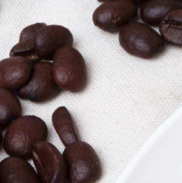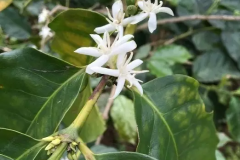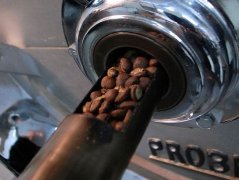Coffee roasting skills basic knowledge, curve adjustment, flavor mastery
The flavor of coffee is largely determined by the qualification of raw beans, and roasting is only a way to show the characteristics of coffee beans.
After roasting, various ingredients of raw coffee beans have undergone chemical changes, thus forming the flavor of coffee. In other words, what kind of chemical change occurs, to what extent, and to what extent to stop the reaction from continuing-these are the main points of baking.
The chemical reactions of various components in raw beans will be affected by both temperature and time. Over time, how the temperature of the coffee bean rises, to how many degrees Celsius (that is, the degree of coloring)-these two points basically determine the flavor of the coffee. Although everyone feels that baking is difficult, the principle of baking is actually very simple. Baking is a continuous reaction of "how many degrees Celsius does the temperature of coffee beans change in a minute?" This continuous reaction needs to be controlled by recording the temperature changing every minute (the temperature shown on the machine is not the temperature of the coffee beans, but the temperature of the baking room, from which the temperature of the coffee beans can be inferred). We record these figures on a chart, using the horizontal axis to represent the time and the vertical axis to represent the temperature, which is called the "coffee baking curve".
Even in the same producing area, if the batches (processing units) of raw coffee beans are different, the proportion of ingredients that make up the baking color will be different, and the coloring methods will be different. Therefore, in order to maintain a stable baking level, the same batch of raw beans should be used as much as possible, and the coloring method of the new batch should be confirmed when replacing the new batch. However, the same batch of raw coffee beans, there will also be a big difference in quality or placed for a long time, resulting in changes in quality. In order to ensure the stability of the baking level of the same batch of secondary beans, we must first ensure the consistency of baking methods. Not only the input of raw beans should be fixed, but also the firepower or air valve should not be adjusted at will. In addition, the baking quantity can be divided into several batches. The first batch can be roasted deeper, and the second batch should be roasted shallower, mixing and blending the coffee beans made twice, so that the uneven baking degree offsets each other.
When baking, it is very important to record the heating mode of coffee beans at all times and to master the "usual" state. If the temperature is different from the usual "popping", it should be corrected according to this difference (for example, if the temperature is 2 ℃ higher than the usual "popping", then the temperature when you stop baking is 2 ℃ higher than usual), and if the baking time is longer (shorter) than usual, the baking temperature should be lowered (higher) accordingly.
Only by mastering the "usual" baking status, can we make micro-adjustments in time to ensure high-precision baking quality. If the temperature changes obviously, you can also turn down the firepower or open the gas valve; if the temperature changes slowly, you can increase the firepower or close the gas valve.
So, how to test the degree of baking? If the quality requirements are very strict, it is necessary to set the color specifications of roasted coffee beans in advance. In order to check whether they meet the specifications, a color meter (colorimeter) can be used to measure color, freshness, brightness and other indicators. The weight loss of coffee beans (the weight change before and after baking) can also be used as a criterion for the degree of baking. If you lose much less weight than usual, it may be because the baking is too deep.

This article is reproduced from the author of the brief book: Royal West Point Culture.
Important Notice :
前街咖啡 FrontStreet Coffee has moved to new addredd:
FrontStreet Coffee Address: 315,Donghua East Road,GuangZhou
Tel:020 38364473
- Prev

Coffee trees introduce how to grow good coffee fruit sources from seeds to fruits.
Coffee is a perennial evergreen shrub or small tree of Rubiaceae, which is a horticultural perennial cash crop. Wild coffee trees can grow to a height of 5-10 meters, but coffee trees planted on manors are often cut to a height of less than 2 meters in order to increase the amount of fruit and facilitate harvesting. Coffee trees will bloom, depending on the origin, about February-March (Northern Hemisphere) or June-July (South).
- Next

Introduction to the characteristics of four different inner pans of coffee roaster
Inner pot characteristics coffee roaster currently has 4 kinds of inner pot! The taste of coffee does not matter, and the use of coffee roasters is also different. 1, the principle of the direct-fired inner pot coffee roaster DISCOVERY to introduce the inner pot after punching processing, the bottom of the burner flame can be in direct contact with coffee beans. The direct flavor is attached to the coffee and becomes fragrant and delicious.
Related
- Beginners will see the "Coffee pull flower" guide!
- What is the difference between ice blog purified milk and ordinary milk coffee?
- Why is the Philippines the largest producer of crops in Liberia?
- For coffee extraction, should the fine powder be retained?
- How does extracted espresso fill pressed powder? How much strength does it take to press the powder?
- How to make jasmine cold extract coffee? Is the jasmine + latte good?
- Will this little toy really make the coffee taste better? How does Lily Drip affect coffee extraction?
- Will the action of slapping the filter cup also affect coffee extraction?
- What's the difference between powder-to-water ratio and powder-to-liquid ratio?
- What is the Ethiopian local species? What does it have to do with Heirloom native species?

